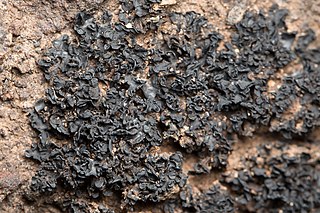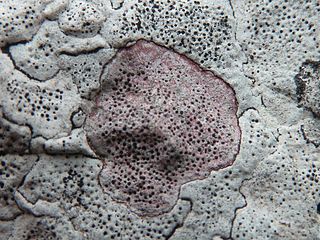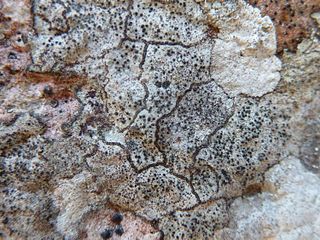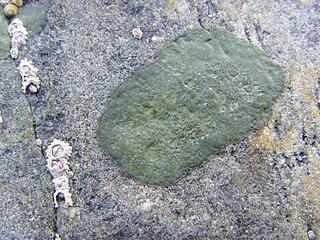
The Lichinaceae are a family of ascomycete fungi. Most species are lichenized with cyanobacteria, and have a distribution largely in temperate regions.

Verrucariaceae is a family of lichens and a few non-lichenised fungi in the order Verrucariales. The lichens have a wide variety of thallus forms, from crustose (crust-like) to foliose (bushy) and squamulose (scaly). Most of them grow on land, some in freshwater and a few in the sea. Many are free-living but there are some species that are parasites on other lichens, while one marine species always lives together with a leafy green alga.
Lasioloma is a genus of lichenized fungi in the family Pilocarpaceae. The genus was circumscribed by Swedish lichenologist Rolf Santesson in 1952, with Lasioloma arachnoideum assigned as the type species. Found predominantly in tropical rainforests, genus Lasioloma contains both foliicolous (leaf-dwelling) and corticolous (bark-dwelling) species. The foliicolous species are distinguished by their woolly prothallus, a thallus that ranges from dispersed to continuous, and a hairy apothecial margin. In contrast, corticolous species typically do not have a woolly prothallus, and their thalli are usually continuous, or unbroken. Regardless of the substrate they inhabit, all known Lasioloma species are characterized by the production of campylidia and branched conidia.

Endocarpon is a genus of saxicolous (rock-dwelling), crustose lichens in the family Verrucariaceae. The genus was circumscribed by German bryologist Johann Hedwig in 1789.
Clavascidium is a genus of lichens in the family Verrucariaceae. The genus was circumscribed in 1996 by Austrian lichenologist Othmar Breuss. Because the type species of the genus, Clavascidium umbrinum, has been shown using molecular phylogenetics to belong to genus Placidium, Cécile Gueidan and colleagues proposed to unite Clavascidium with Placidium in a 2009 publication. Despite this, the genus has been retained in recent publications of fungal classification.

Catapyrenium is a genus of lichens in the family Verrucariaceae. The genus was circumscribed by German botanist Julius von Flotow in 1850.

Bagliettoa is a genus of lichen-forming fungi in the family Verrucariaceae. The genus was circumscribed by Italian lichenologist Abramo Bartolommeo Massalongo in 1853. Bagliettoa species are endolithic, growing between the grains of solid rock.
Anthracocarpon is a genus of lichen-forming fungi in the family Verrucariaceae. The genus was circumscribed by Austrian lichenologist Othmar Breuss in 1996 with Anthracocarpon virescens assigned as the type species.

Placidiopsis is a genus of lichens in the family Verrucariaceae. The genus was circumscribed by Italian naturalist Francesco Beltramini de Casati in 1858, with Placidiopsis grappae assigned as the type species.
Neocatapyrenium is a genus of squamulose lichens in the family Verrucariaceae. It has five species. The genus was circumscribed by Hiroshi Harada in 1993, with Neocatapyrenium cladonioideum assigned as the type species.
Involucropyrenium is a genus of lichens in the family Verrucariaceae. It has nine species. The genus was circumscribed by Austrian lichenologist Othmar Breuss in 1996, with Involucropyrenium waltheri assigned as the type species.

Heteroplacidium is a genus of lichen-forming fungi in the family Verrucariaceae. The genus was circumscribed by Austrian lichenologist Othmar Breuss in 1996 with Heteroplacidium imbricatum assigned as the type species. It was proposed as a segregate of Catapyrenium. Other morphologically similar genera are Neocatapyrenium, Placidium, and Scleropyrenium, although molecular phylogenetic analyses indicate that they are independent monophyletic lineages within the Verrucariaceae.

Thelidium is a genus of lichen-forming fungi in the family Verrucariaceae. The genus was circumscribed in 1855 by Italian lichenologist Abramo Bartolommeo Massalongo, who assigned Thelidium amylaceum as the type species.

Peltula is a genus of small dark brown to olive or dark gray squamulose lichens that can be saxicolous ) or terricolous. Members of the genus are commonly called rock-olive lichens. They are cyanolichens, with the cyanobacterium photobiont from the genus Anacystis. They are umbilicate with flat to erect squamule lobes that attach from a central holdfast or cluster of rhizenes. Lichen spot tests are usually negative.

Hydropunctaria is a genus of saxicolous (rock-dwelling), crustose lichens in the family Verrucariaceae. The genus includes both aquatic and amphibious species, with members that colonise either marine or freshwater habitats. The type species, Hydropunctaria maura, was formerly classified in the large genus Verrucaria. It is a widely distributed species common to littoral zones. Including the type species, five Hydropunctaria lichens are considered marine species: H. adriatica, H. amphibia, H. aractina, H. orae, and H. oceanica.

Parabagliettoa is a genus of crustose lichens in the family Verrucariaceae. It has 3 species. The genus was circumscribed in 2009 by Cécile Gueidan and Claude Roux, with Parabagliettoa dufourii assigned as the type species.

Sporastatia is a genus of crustose lichens in the family Sporastatiaceae. It has four species. Sporastatia lichens are long-lived species that grow on siliceous or weakly calcareous rocks in arctic and alpine locales.

Wahlenbergiella is a genus of saxicolous (rock-dwelling), crustose lichens in the family Verrucariaceae. It has three species, all of which live in marine intertidal zones where they get periodically immersed in seawater. Wahlenbergiella closely resembles another lichen genus that includes marine species, Hydropunctaria. Wahlenbergiella was circumscribed in 2009 by Cécile Gueidan and Holger Thüs. They initially included two species: W. striatula, and the type,W. mucosa. The generic name honours Swedish naturalist Göran Wahlenberg, who originally described both of these species.
Trimmatothele is a genus of saxicolous (rock-dwelling), crustose lichens in the family Verrucariaceae. It has five species. The genus was formally published by lichenologist Alexander Zahlbruckner in 1903. The type species, Trimmatothele perquisita, was originally collected from Norway by Johannes M. Norman, who placed it in the genus Coniothele in 1868. Diagnostic characteristics of Trimmatothele include a thin thallus with a smooth surface; small perithecia that are partially immersed in the substrata and have an involucrellum; asci that contain multiple ascospores; and small, simple ascospores. Trimmatothele has been described as one of the most poorly known genera of lichens due to the rarity of its species, the few available herbarium specimens, and some missing type specimens.

Catapyrenium boccanum is a species of squamulose (scaley), rock-dwelling lichen in the family Verrucariaceae. It grows on mortar or on calcareous rock. Its squamules are up to 4 mm wide, pale to dark brown with black margins and a black underside. Ascospores measure 11–15 by 5–8 μm. Because of its combination of squamulose thallus, simple ascospores, and lack of algae in the hymenium, this species is a "catapyrenioid" lichen, of which more than 80 exist in the Verrucariaceae.














